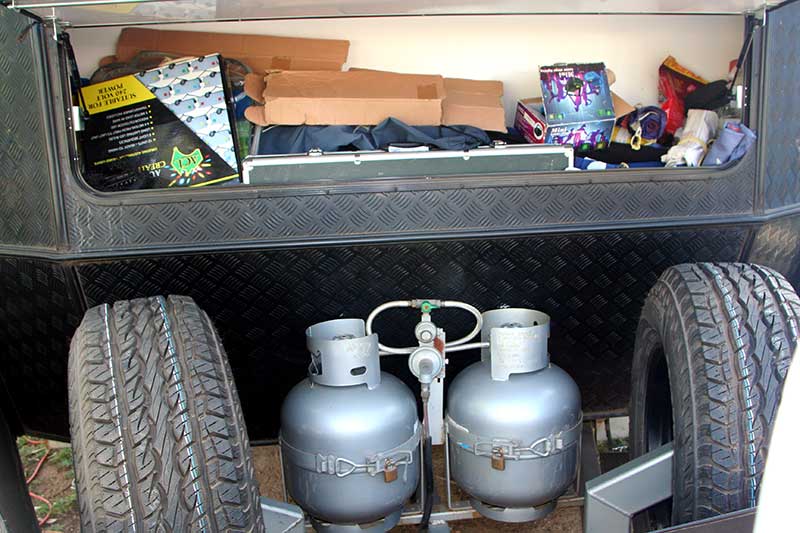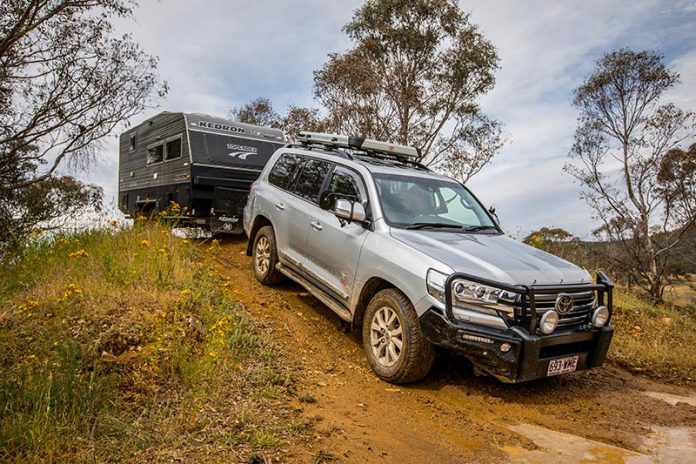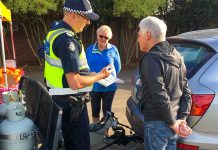It’s every caravanner’s worst fear: a sway that quickly gathers steam until, like an unpredictable double pendulum, it jerks out of control. On the eve of the festive season, this dash-cam footage acts as a necessary warning about safe towing.
While it’s unclear exactly how this particular accident happened (which presumably occurred in the US), the outcome is serious. And it starts with that same gentle sway we’ve all felt before. However, sticking to some cardinal rules – from loading the van to towing it properly – will greatly reduce the chances of jack-knifing and overturning a caravan.
THE TOW TUG
This one is obvious: make sure your tow vehicle is legally able to tow the trailer. Is the towing capacity equal to or greater than the van’s Aggregate Trailer Mass? Is the vehicle’s towball maximum sufficient once the van is loaded?
While some vehicles have no problems towing what their manufacturer claims they can, other vehicles are simply too light or don’t have the wheelbase to be a stable towing platform to haul heavy trailers, regardless of what the manufacturer says about its towing capacity. Some judgement and common sense will go a long way here.
My own vehicle, for example, is rated to tow 2500kg (250kg towball download), but it performs best as a tow tug when lugging no more than 2000kg.
Now, this is not true of all vehicles. Larger, heavier 4WDs, such as the Land Cruiser 200 or 70 Series, the Y62 Patrol or Jeep Grand Cherokee, each rated to tow 3500kg, do it well. But some of the one-tonne utes that are claimed to tow 3500kg are somewhat… marginal when loaded right up – they are just too light.
The moral: don’t assume it’s okay to tow a trailer that weighs exactly what your vehicle’s manufacturer claims it can. It might, strictly speaking, be legal. But is it smart?
LOADING THE VAN
How you load your caravan is crucial. To be stable, a caravan must have a certain amount of towball download weight. Place the heaviest items over the van’s axle and load gradually towards the front of the van, not the rear.

Putting heaving loads behind the axle will reduce the weight being imposed on the vehicle’s towbar by the van’s coupling. And while this may sound like a good thing, it will, in fact, only set-up the van to sway.
Never exceed your van’s Aggregate Trailer Mass. If it says 2500kg ATM on the compliance plate, then that’s all your van can weigh (disconnected from the tow car) after it’s been loaded up. End of story.
LOADING THE VEHICLE
What does your vehicle’s manufacturer say about its Gross Combined Mass? This figure refers to the total permissible weight of the van and vehicle combined. The vehicle might be rated to tow, say, 3500kg, but what if the vehicle’s Gross Combined Mass is 6000kg (total weight of the trailer and vehicle combined)?
In this example, towing 3500kg would mean there’s only 2500kg left to account for the weight of the tow vehicle, its occupants, the fuel, luggage and aftermarket accessories.
STOPPING SWAY
This one is controversial. Campfire lore has it that a driver should speed up to counter a swaying van. “My dad reckons you should just floor it.” Words we’ve all heard before.
But is there any truth to this?
Well, sort of. The principle is that by accelerating, you’re ‘stretching out’ the combination. But in reality, there are few tow vehicles with the necessary engine performance to carry out this feat. Vehicle such as the aforementioned 200 Series and the Range Rover Sport might be up for it, while others would struggle mightily.
But you can achieve this same affect by maintaining your speed and pressing the override button on the electric brake controller, thereby independently slowing the van.
Caravan sway control is also highly recommended. This will kick in as soon as sway is detected and stop it in its tracks.
LOAD LEVELLERS
These are important devices, certainly, but they are not a substitute for a properly loaded caravan.
As you’d know, load levellers work by ‘levering’ some of the force being applied at the rear of the van to the front end of the vehicle, thereby returning traction and handling to the vehicle’s front wheels. They can also have the happy side-effect of reducing some sway, but it’s important to note that this is not their primary purpose.
DRIVING AND BRAKING
It should go without saying, but drive/tow according to the prevailing conditions and within the limitations of your rig. Some caravan/vehicle combinations perform well at highway speeds, while to sit on 100km/h for others is a bit too much to ask.
It’s good practice to periodically check the setting of your electric brake controller at low speed on a quite stretch of road. Over-adjust the van’s brakes and you will chew through its brake pads in no time. Under-adjusting will create a dangerous over-reliance on the vehicle’s brakes (also leading to premature wear of its brake pads).
Adjust the controller until both the van and the vehicle brake together as a single ‘unit’, without the van pulling or pushing the vehicle.
How else can a driver avoid caravan sway? Leave your comments below.







Load levellers or Weight DISTRIBUTION hitches, do that, they re distribute the weight that has come off the front wheels when hitching Up the van to the back of the car. They DISTRIBUTE the weight more evenly, then, across all wheels including the wheels of the caravan. Don’t forget the 60/40 rule, ie 60% of the added weight forward of the axles and 40% behind the axles. So, wine, books, canned food, heavier items to the front.
Thanks Bruce, you’re absolutely right.
Great article, however it must also be noted that correct tyre pressure is paramount when towing for the tug and the trailer.
4 years ago we purchased our 3rd new caravan, this time intending to do some rough road exploring during our first around Oz trip. I had the manufacturer add a 3rd 95L water tank, a grey water tank and a 2nd spare tyre. Unfortunately it seems that engineers were not employed in the redesign with no re-jigging the weight distribution and within 15 minutes of taking possession of the van (when merging on to the Hume Hwy in northern Victoria) our caravan swayed drastically, the first I’ve ever experienced. And it happened again within a week during our shake-down trip home.. The manufacturer ignored my concerns. I have had Alko ESC fitted and also now travel with a Hayman Reece Anti Sway Kit fitted. I have since had no problems. What was disturbing was the manufacturer’s “head in the sand” attitude – for an otherwise superb caravan fitted with a D035 hitch and Cruisemaster suspension, Tare of 2632kg and ATM of 3232kg.
load your van correctly and drive at a speed that you feel is comfortable for you if you get into trouble it is easy to make the correct judgment to help right the problem.
Make sure your ball is as close to the diff as possible. Reduces the need wdh and gives the tow vehicle more leverage over the van or more stability
Cars towing trailer and vans should stick to the trucks speed limits, ie WA speed limits are 110km/h for cars and bikes, trucks and cars with trailer is 100km/h
Good article Max and I agree 100% with your comments on GCM and believe there is not enough knowledge out there on what the manufacturer say about its Gross Combined Mass?
I recently ordered my new caravan, which will have a tare weight of around 3000kg. I have a Holden Colorado and due to the 6000kg GCM rating on this vehicle, I am now upgrading my tow vehicle. I was amazed and disappointed with lack of knowledge relating to GCM and believe that Caravan Sales Staff should be required to have a better knowledge when it comes to caravan weights, tow vehicle capability and each vehicles GCM.
Question for another day – As part of the sales process should a Caravan Sales Rep be accountable and / or ensure this information is passed on to the purchaser?
Safe towing.
Maybe it is time we took some responsibility for our own actions. If you are paying the big dollars for a new van would you not be a little interested in knowing a bit more about your own setup? Its not always someone else’s fault for your lack of knowledge ore ignorance.
If possible get a tug with as little as possible overhang behind the rear wheel as earlier ozzie utes did, brings the tow ball closer to rear axle. Use heavier tyres 6 or 8 ply take the sway out of the walls. Some of the later model vehicles are soft and comfy with multi link suspension, find some thing stiff like leaves.
Martin, I couldn’t agree more. My first question if buying a new van would be asking the salesman if they own a caravan, especially at shows.
Dealerships should have a legal duty of care to ensure tow vehicle is capable of safely towing the load. Obviously they can’t be fully liable as there are to many loading variables outside their control.
It is also time the caravan industry bodies start policing manufacturers more. There are still vans being produced that don’t even meet licence plate ADR’s so what else are they ignoring.
When I purchased my new van 5 yrs ago the salerman only looked at the tow bar rating, 3500kg. Vehicle was 3ltr Patrol. Max towing 3200kg.
Van ATM 2954kg
Tare 2554kg
Van weighed 178kg more that stated empty with no gas bottles or water, nothing inside as well.
Manufacturer issued a new compliance plate with extra 200kg.
Now new tow rig but have to watch my weight
A question is it true if the combine weight of you van and tow vehicle exceeds 5 tonnes you are restricted to 100 kph?
https://www.caravansplus.com.au/guides/how-to-stop-your-caravan-swaying-must-see-video-a-4.html
Here is a great link to a video on caravan sway and show what has been stated in the article as correct loading is vital.
when the caravan is not level ,the caravan pivots on the front axle ,leaving a big overhang to the rear of the van this is what causes rear sway .it is vitally important to adjust the towbar height to level up the caravan .and fit a weight disturbing hitch to stop the see sawing of the caravan on undulating roads ..never ever speed up when you detect sway ,no matter what you tow i have owned 9 caravans since i was 24 yrs old i am now 68 yrs old and still traveling every where in my 26 ft caravan and my trusty tow car i have ,towed them with cars and 4 wds …. i got my first weight disturbing hitch for my 23 ft Chesney in 1976 ,and immediately learnt the value of it .i towed it with my V 8 valiant station wagon ,around Australia many times ,then a 27ft 6 viscount ,then a range of other caravans towed with a range of cars and 4 wds on dirt roads ,freeways ,cow paddocks sand hills ,from the harbour bridge to kings canons .i have seen many caravans sway around in front of me as i ride in complete confidence ..and don’t for that you must have about 10 % down weight on you tow ball ……
Dean Reynolds March 6th 2018
Excellent article … wish all caravans would read it.
Common sense and experience counts in every situation as does the road conditions. I tow with a diesel Jeep Grand Cherokee and 2,500 Kg Van with no problems. Fitted a Dexter anti sway last year to the van as an extra. Excellent system well worth the money. Amazing road holding in all conditions including those difficult side winds. Lower speed and alert mental reaction times always prevail. Have travelled the entire Australian coast. It is a constant concern as to how many vans are currently towed illegally by under powered or sized cars, which makes the entire rig both extremely dangerous and uninsured to these ignorant travellers.
Safety is very important with towing. You’ve outlined some very crucial safety tips when towing. Great writeup. Cheers!
Should sway be initiated immediately apply the caravan brakes only via the manual override function on the brake controller. Once under control pull up and review the loading situation. Eliminate heavy loads from extremities e.g. dual spares and bins attached to the rear.
HI Everyone,
wondering if you could help. We purchased a 19′ 6″ dual axle van (ATM 3300, GTM 3000) a little over a week ago. Has the DO35 Hitch. Pulling it with a 2018 Holden Colorado Twin Cab (rated 3.5 tonne).
Havent added any load leveling device yet.
Dont have a bull bar or canopy on ute at this stage.
As soon as we get to 80km/hr the van starts to sway and it feels really light on the front end of the car (steering).
1. Will a bull bar help?
2. What is best load leveling device to use with DO35 hitch?
3. What are we doing wrong?
The van is NOT overloaded.
Thanks so much for your suggestions/recommendations.
Totally agree with comments. One factor overlooked though was keeping CofG low. Any items stored in overhead or top cupboards should be the lightest items and kept to a minimum. Anything heavy should be as low as possible.